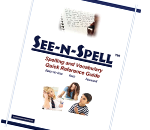See-N-SpellTM
Spelling and Vocabulary Quick Reference Guide

♦ Easily find the correct spelling of 300+ commonly used American English words just by knowing the sound of the first letter or first few letters
♦ Identify the correct spelling and usage of ‘sound-alike’ words (homophones)
♦ Quickly determine the correct spelling of commonly misspelled words
♦ Verify the correct usage of these words
1. Most Commonly Used Vocabulary Words
2. Commonly Misspelled Words
3. My Special Interest Words
With just 40-pages in the See-N-Spell™ booklet, users can simply flip to the page showing the first letter (a,b,c, etc.) of the word, then scan down the page and copy the correct spelling. See-N-Spell™ is not intimidating and is easy-to-use.
Writers can compose written work using broader and more advanced vocabulary when they have confidence in their ability to spell words correctly. Technology Supports for Struggling Writers lists twelve characteristics of struggling writers and seven of them relate to spelling and vocabulary skills in some manner.
Writers typically possess a larger everyday spoken (social) language vocabulary than written academic language vocabulary. They might use a word conversationally, know the sound of the first letter, the first few letters in a word and/or can recognize the word in print but still not be confident about how to spell the word correctly. These writers often misspell or, to avoid misspelling, choose simpler words that do not clearly express their thoughts or develop their language skills (e.g., choosing the word “hard” rather than “difficult”).
The See-N-Spell™ Spelling and Vocabulary Quick Reference Guide alphabetically lists the 300+ most common vocabulary words and the most commonly misspelled words in the (American) English language to help writers to correctly and confidently compose written work. It can be used by writers of any age as an “at-a-glance” resource for correct spelling and language function of the most common words used in daily communication.
The typical answer to this is “If I don’t know how to spell it, how can I find it in a dictionary?” Other common answers are “I can’t use those 3-inch-thick dictionaries”, or “I don’t want to take the time”, or “I know what it means, I just don’t know how to spell it” or “I can just use SpellCheck” (even though most Upper Elementary/Secondary School draft composition work is still handwritten).
The need for correct spelling and adequate vocabulary is not limited to English Literature and Composition courses…they are essential components of success in Social Studies, STEM, as well as in the world of business.
McKay, Davies, Devin, Clayton, Oliver, and Zammit,
The Bilingual Interface Project Report
ESL (ELL) individuals may exhibit fairly advanced social English skills but actually possess very limited academic English proficiency. Such people will find See-N-Spell™ to be particularly useful in light of the unique and difficult variations in American English words. Examples: Is the word related to the act of listening spelled “hear”, or “here”? Is it a noun, verb or adverb or does the spelling change as usage changes? Is the leader of a school spelled “principal” or principle”? What is the difference in meaning between “capital” and “capitol”?
ESL (ELL) individuals may exhibit fairly advanced social English skills but actually possess very limited academic English proficiency. Such people will find See-N-Spell™ to be particularly useful in light of the unique and difficult variations in American English words. Examples: Is the word related to the act of listening spelled “hear”, or “here”? Is it a noun, verb or adverb or does the spelling change as usage changes? Is the leader of a school spelled “principal” or principle”? What is the difference in meaning between “capital” and “capitol”?
Recommended for Grade 4 through Adult